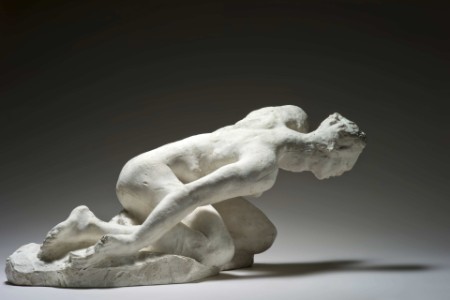Crossing medium
Rodin was born in 1840, just two years after Louis Daguerre (1787–1851) who invented an initial form of photography, called daguerrotypes. Photography facilitated what we might recognise today as Rodin’s ‘entrepreneurial’ spirit and he used the medium to disseminate and advertise his work, an enterprising approach likely shaped by his early training in commercial and decorative art studios.
However, Rodin also made photography part of his creative process as is demonstrated by the historic images included in Tate’s exhibition. Photography, a light-hungry medium, provided sharp focus on the dull materiality of plaster, capturing every casting line, splatter mark and many fine undulations inscribed upon its surface, therefore allowing Rodin to consider his formal choices in new ways.
A keen draftsman, Rodin would reinvent and transform an initial drawing in the same way he put his sculptures through multiple metamorphoses. The exhibition includes several of his watercolour works in which the washes appear to replicate his sculptural practice. In his quest for a soft and even light which he described as ‘half-tone’ – a term he has written on one drawing shown in the exhibition – he developed a watercolour style that imitates what is technically known as lait de plâtre, a diluted mix of plaster powder and water.
Collaborators
Joining forces with leading contemporaries in photography such as Henry Coles, Gertrude Käsebier and Edward Steichen, Rodin broke new ground exploring the potential of cross-medium practice. This innovative process inspired well-known successors like Pablo Picasso and Brassaï to revisit these ideas in the 1930s.
Rodin also worked with casters, carvers and founders, often collaborating with up to twenty different technicians at any given time. His collaborators were typically trusted colleagues whom he would occasionally encourage to insert their own stylistic or aesthetic choices, although he still supervised these processes closely. Many of his best-known works in marble or bronze are the product of complex workshop collaborations, whereas the plaster casts made from the original clay models bring us closest to the artist himself.
‘The EY Exhibition: The Making of Rodin’ is curated by Nabila Abdel Nabi, Curator, International Art, Tate Modern; Chloé Ariot, Curator for Sculpture, Musée Rodin, Paris; and Achim Borchardt-Hume, Director of Exhibitions and Programmes, Tate Modern; with Helen O’Malley, Assistant Curator, Tate Modern. The exhibition is organised by Tate Modern and Musée Rodin, Paris.
Image credit: Auguste Rodin Etude pour Iris c.1891–93 Musée Rodin, S. 00851


